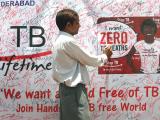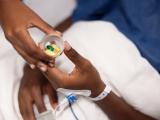A new rapid molecular test has shown the ability to detect, with reasonable certainty, mutations associated with multidrug-resistant tuberculosis (MDR-TB), an international team of researchers reported today in the New England Journal of Medicine.
In head-to-head comparisons against the gold standard tests for TB drug susceptibility, the cartridge-based, automated assay was able to identify mutations associated with resistance to isoniazid, fluoroquinolones, and aminoglycosides with relatively high sensitivity and specificity. Detection of resistance to fluoroquinolones and aminoglycosides is important because they are core components of the World Health Organization (WHO)-endorsed shortened treatment regimen for uncomplicated MDR-TB.
Incorrect treatment of MDR-TB is associated with higher morbidity and mortality and ongoing transmission of the disease, the authors note, and tests that can rapidly identify patients who are eligible for the shortened treatment are needed, as current culture-based drug-susceptibility tests can take 2 to 6 weeks and require substantial laboratory equipment and training. The investigational assay tested in the study, which analyzes sputum samples from TB patients for genetic mutations, is able to produce results in just over 2 hours.
The results of the study could be a significant development in global efforts to combat MDR-TB. Xpert MTB/RIF, a rapid molecular test currently used to simultaneously detect the presence of Mycobacterium tuberculosis and identify resistance to the first-line TB drug rifampin, has greatly enhanced the ability to detect drug-resistant TB cases, but it is not able to identify resistance to other TB drugs.
"I think it's an important study," said David Dowdy, MD, PhD, an infectious disease epidemiologist at Johns Hopkins Bloomberg School of Public Health who was not involved in the study. "It shows that we now have the ability to test for most second-line drugs with good accuracy, directly from sputum, and with results being available in just a couple of hours. It will be very helpful for patients with drug-resistant TB, to make sure that they are started on the right treatment from day one."
High resistance to critical antibiotics
In the prospective study, the researchers tested the diagnostic accuracy of the assay in 308 patients from South Korea and China who had symptoms of pulmonary TB. The results of the molecular test were compared with the results of phenotypic culture-based drug-susceptibility testing and DNA sequencing, which also looks for mutations associated with drug resistance.
M tuberculosis resistance to isoniazid, fluoroquinolones (ofloxacin and moxifloxacin), and aminoglycosides (amikacin and kanamycin) is associated with 25 mutations in six genes and promoter regions, the authors note.
Phenotypic drug-susceptibility testing identified 194 of 308 patients (63%) as having infections resistant to one or more TB drugs, including 55 with MDR-TB (defined as TB that is resistant to at least rifampin and isoniazid), 54 with MDR-TB that was also resistant to fluoroquinolones or aminoglycosides, and 39 with extensively drug-resistant TB (defined as MDR-TB with additional resistance to any fluoroquinolone and at least one of the three second-line injectable drugs—amikacin, kanamycin, or capreomycin).
Compared with the culture-based test, the sensitivity and specificity of the investigational assay for detecting resistance were 83.3% and 99.2% for isoniazid, 88.4% and 96.6% for ofloxacin, 87.6% and 94.3% for moxifloxacin, 71.4% and 98.4% for kanamycin, and 70.7% and 99.6% for amikacin.
When compared with DNA sequencing, the sensitivity and specificity of the molecular test for the detection of resistance mutations were even higher: 98.1% and 100% for isoniazid, 95.8% and 100% for both fluoroquinolones, 92.7% and 99.6% for kanamycin, and 96.8% and 100% for amikacin.
This latter finding is important, the authors note, because the WHO has set a target for the diagnostic sensitivity and specificity of next-generation molecular drug-susceptibility tests of 95% and 98%, using DNA sequencing as the reference standard. When compared with DNA sequencing in this study, the investigational molecular assay met the sensitivity target for isoniazid, fluoroquinolones, and amikacin but missed the sensitivity target for kanamycin. The specificity target was met for all drugs.
Furthermore, the assay was able to identify 48 of 53 patients (90.6%) who had TB without resistance to fluoroquinolones or aminolgycosides and therefore would be microbiologically eligible for the shortened treatment regimen, and 81 of 92 patients (88%) with TB that was resistant to one or both of those drugs. That means those patients would be properly identified as inappropriate candidates for the shortened treatment regimen, potentially sparing antibiotic doses.
"We speculate that a positive test result could be used to triage patients away from the new shortened treatment regimen for multidrug-resistant tuberculosis and toward treatment centers with the capacity for comprehensive drug-susceptibility testing and with experience treating highly drug-resistant tuberculosis," the authors write.
According to WHO estimates, there were 480,000 new cases of MDR-TB in 2015, and a recent report in The Lancet Respiratory Medicine estimated a mortality rate of around 40% for MDR-TB patients. WHO officials have identified the development of rapid molecular tests, along with immediate access to effective, high-quality treatment, as high-priority actions for addressing the MDR-TB crisis.
See also:
Sep 14 N Engl J Med study
Mar 23 CIDRAP News story "Report warns of rise in drug-resistant tuberculosis"
























